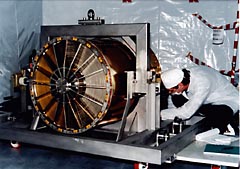
There are actually three complete sets of X-ray telescopes on-board the satellite, each of which consists of 58 wafer-thin nickel mirrors. The mirrors are gold-plated and nested in each other just a few millimeters apart. XMM-Newton's nested mirror design made it possible to have the largest collecting area of focusing optics deployed for X-ray astronomy. The total mirror surface area exceeds 120 square meters, larger than a tennis court. No previous X-ray satellite could focus even approximately as much radiation as XMM-Newton.

|
The image on the left shows the XMM mirror module being testing at the Centre Spatial de Liege, an optical test facility in Belgium. The module is viewed from the "front", i.e. the side from which photons enter during operation. In front, one can see the "spider" on which the 58 mirror shells are mounted. |